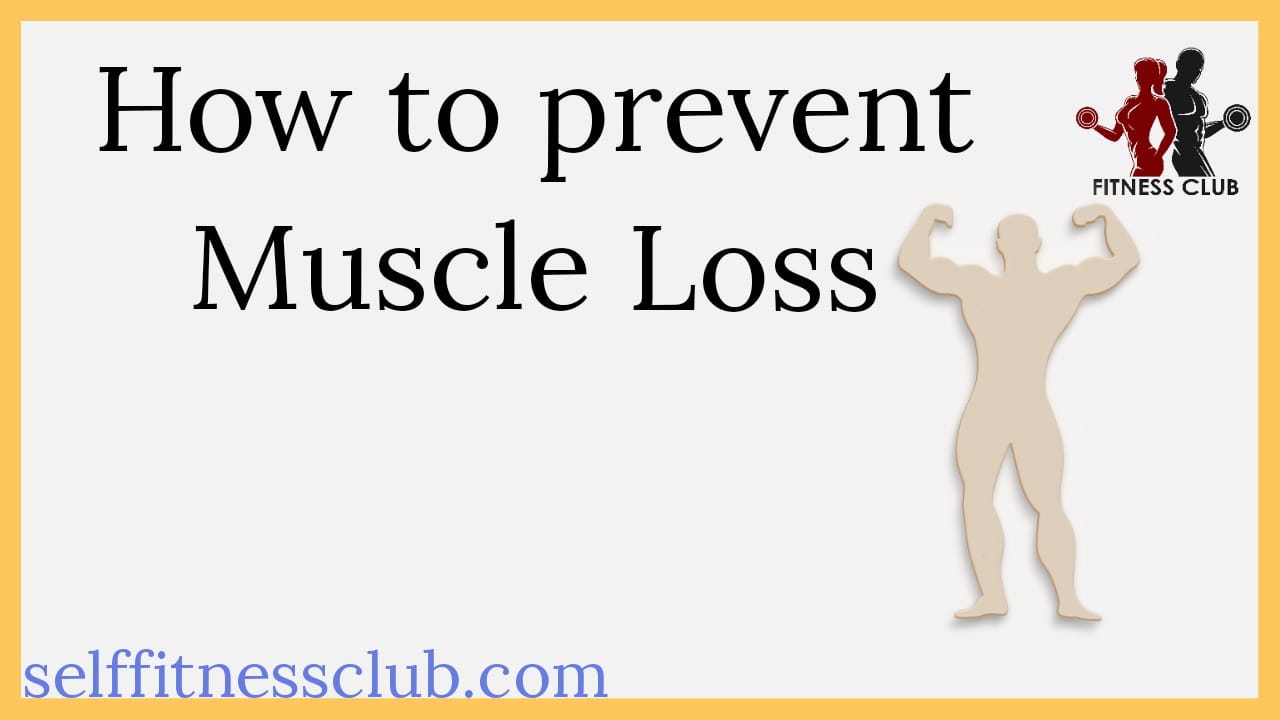Sarcopenia, also known as muscle loss, is a common condition that affects at least 10% of adults, over 50 years of age. Research says that it can decrease life expectancy and quality of life. However, there are some measures you can take to prevent and even reverse the condition.
Table of Contents
Things To Eat To Prevent Muscle Loss
A healthy diet should be the focus at the time, which can increase lifespan and quality of life.
But before delving directly into the prevention of muscle loss, it is necessary to understand the exact meaning of muscle loss, its causes, whether it is natural, or it is triggered by some action, if you can do something to prevent it beforehand, and so on.
About muscle loss
Muscle Loss, or Sarcopenia, literally means “lack of flesh.” It is a condition of age-associated muscle degeneration that is said to be more common in people over 50 years old.
- According to research, after 30 years of age, adults lose approx 1% of their muscle strength every year, on average, which restricts their ability to perform many day-to-day activities. Moreover, muscle strength also declines by 12-15% per decade.
- Furthermore, muscle loss also shortens life expectancy in those it affects, as compared to individuals with normal muscle strength.
Causes of muscle loss
Muscle loss is caused by an imbalance between signals for muscle cell growth (anabolism) and signals for teardown (catabolism). Moreover, growth hormones act with protein-destroying enzymes to keep your muscles steady through a continuous cycle of growth, stress or injury, destruction, and then healing. This cycle is always occurring, and when things are in balance, muscle keeps its strength over time. However, during aging, the body becomes resistant to the normal growth signals, bending the balance toward catabolism and muscle loss.
Therefore, although aging is the most common cause of muscle loss, other factors in your lifestyle can also trigger this condition.
- Sedentary Lifestyle: Lack of muscle movement is one of the strongest triggers of sarcopenia, leading to faster muscle loss and increasing weakness. This can also be due to bed rest or immobilization after an injury or illness leads to rapid loss of muscle. Moreover, it has been found that 2-3 weeks of decreased walking and other regular activity is enough to decrease muscle mass and strength, which results in body fatigue, making it very difficult to return to your normal, active lifestyle.
- Unbalanced diet: A low-calorie and low-protein diet results in weight loss and diminished muscle mass. This is more common with aging, due to changes in taste buds, problems with the teeth, gums, and swallowing, and/or increased difficulty in shopping and cooking a healthy, wholesome diet,
- Inflammation: Chronic or long-term diseases like rheumatoid, arthritis, severe burns, etc. can result in inflammation, which disrupts the normal balance of teardown and healing, resulting in muscle loss.
- Extreme stress: Muscle loss is also said to be more common in health conditions that increase stress on the body. For instance, people with chronic liver disease, and some with chronic heart failure, experience this, due to increased stress on the body and decreased muscle activity. Kidney diseases and cancer treatments also place great stress on the body, resulting in muscle loss.
Indicators of muscle loss
Before making a decision, be it in terms of changing your diet, your exercise regime, or making any lifestyle changes, it is necessary to be sure that you are dealing with muscle loss, and not something else. Here, we list down some common indicators that point toward muscle loss. However, sometimes the indicators of muscle loss are also experienced during other medical conditions. So, if you are unsure, it is always better to go for a professional medical opinion, instead of making a hasty decision.
- The primary indicator of muscle loss is when you feel your muscle strength diminishing. You begin to feel physically weaker and face more difficulty than usual while lifting familiar, everyday objects.
- This decreased strength might pop up while doing other activities too, including walking more slowly, becoming exhausted more easily, and having less interest in being active.
- Losing body weight without even trying can also indicate muscle loss.
If left unchecked, muscle loss can lead to a host of issues later in life, including disability and increased mortality risk due to frailty. It also ups your odds for metabolic disorders and type 2 diabetes-since muscle tissues help regulate blood sugar, insulin, and other hormones.
Nutrients that prevent muscle loss
It is no secret that diet and exercise keep our bodies running at optimum levels. Therefore, eating nutritious meals can easily help you retain your muscle. You should eat plenty of fruits, veggies, and nuts that will provide the protein, carbohydrates, healthy fats, and vitamins that are necessary for muscle retention. Snacking on some almonds, walnuts, sunflower seeds, and hemp seeds, instead of regular biscuits, is also recommended to get your daily dose of nutrients. Moreover, you can also feed your cravings (and muscles!) through some tasty dishes like gluten-free almond cake or homemade granola bars. And do not forget to pair these nutrient-filled diets with limited amounts of saturated fat, sodium, and added sugar, because these refined carbohydrates lead to the development of insulin resistance, which, in turn, increases silent inflammation, and aids muscle loss.
And also, set a reminder, if necessary, to eat 5 or more servings daily of a combination of vegetables and fruits, especially green, orange and yellow vegetables; dark-colored berries; and citrus fruits.
Protein
Protein intake directly signals your muscle tissue to build and strengthen. But, as you age, your muscles become more resistant to this signal, so you need to increase your consumption of protein to help your muscles grow.
The amino acids in protein are the building blocks of muscle, which is why diet tops the list of changes you are advised to make, in order to prevent muscle loss.
To build muscle, some say that you need 0.45 g of protein per pound of body weight. For example, a person weighing 140 pounds should eat 63 grams of protein a day (140 x 0.45).
However, the amount of protein needed also depends on one’s stage of life. Generally, during periods of growth, injury, or illness, individuals have relatively higher protein needs, than normal. However, as we grow older, our body becomes less effective at utilizing the protein consumed and therefore, less efficient at making new protein cells. Thus, you should try to be intentional about consuming protein-rich foods to maintain muscle mass and strength.
Though it is a bit more than what is usually recommended for general health and good nutrition, many suggest that getting a consistent, moderate 30 g dose at mealtimes appears to be optimal for building and maintaining lean muscle mass. This is equivalent to eating a three-egg omelet with ½ cup hard cheese or 1 cup of Greek yogurt with an ounce of almonds mixed in or a cooked 4-ounce hamburger or 5-ounce salmon filet.
Moreover, some of the best sources of making protein a part of your diet that is recommended by professionals, include milk, cheese, eggs, poultry, fish, peanuts, and beans.
While food sources are the best, supplemental protein, like protein powders, can also help if you struggle with consuming enough calories and protein from your regular diet.
Whey protein has the highest biological value (i.e. a way of rating protein based on how much is actually absorbed, retained, and used in the body) of all proteins, and contains amino acids that directly have a positive impact on cellular health, muscle growth and protein synthesis. Research-based trials have also shown that whey protein supplementation increases strength and muscle mass in elderly subjects involved in a weight-training program. It is recommended to consume 25-50 g of whey protein daily.
It has been found that the amino acid leucine is particularly important for regulating muscle growth and preventing muscle loss. But the quantity of leucine that your body might need can vary. But, for reference, experts recommend that for every gram of protein you take, you need 55 mg of leucine.
Sesame seeds are the highest in leucine, with 2307 mg per ounce. Sunflower seeds, cashews, and almonds are other great sources of this amino acid. You can easily add them as a topping to your meal or carry them with you as a sustaining snack.
Other rich sources of leucine include whey protein, meat, fish, and eggs, as well as soy protein isolate.
Dairy products, especially those high in whey protein like milk and Greek yogurt, which are excellent sources of leucine, are particularly recommended by experts.
Carbohydrates
Protein is critical, but you also need carbohydrates to help build strong muscles. Carbohydrates are the energy source your body uses to be able to exercise as well as perform day-to-day activities.
Middle and older-age adults, especially, should not be on a low-carbohydrate diet.
However, you must ensure to choose only healthy carbohydrates. Vegetables, fruits, and whole grains are preferable to highly processed foods that might be full of carbohydrates. Whole, fresh foods also have vitamins and other nutrients your body needs.
Also, to maximize muscle growth and improve recovery, consuming a drink or meal with a carbohydrate-to-protein ratio of about three-to-one or four-to-one within 30 minutes after your workout is advised. For example, a good choice is 8 ounces of chocolate milk, which has about 22 g of carbs and 8 g of protein.
Vitamin D
Vitamin D deficiency is said to be directly related to muscle loss. Therefore, taking vitamin D supplements can increase muscle strength and reduce the risk of muscle loss.
This is because getting adequate vitamin D helps with muscle protein synthesis and fights inflammation, both of which translate into better muscle strength, power and balance.
It also plays an important role in preserving Type II muscle fibers, and can also act as a natural muscle relaxer for neck pain if you find you have overdone it after a workout.
Your recommended daily requirement of this vitamin is 1000-1200 mg per day if you are above 50 years old.
Vitamin D Dairy is an excellent source of Vitamin D and upping your intake of that helps you prevent muscle loss.
If you are sensitive to dairy, you can still reap the benefits of Vitamin D with tofu or soy milk. Soymilk measures the same as regular milk while a half cup of tofu provides 253 mg.
Moreover, you get sufficient vitamin d during your adulthood. But as you age, your body becomes less able to make vitamin D through sun exposure (it takes four times as long in people over 60), and it’s tough to get enough through diet as well. So, if that is the case, you might intake the vitamin through a pill. However, you must consult your doctor before popping in any type of pill.
Omega-3 Fatty Acids
These essential fatty acids are known to boost everything from heart health to mood. And research has also linked omega-3s with muscle maintenance.
While inflammation in the body causes the muscle to break down, omega-3s act as anti-inflammatory powerhouses, which therefore help prevent muscle loss
These omega-3s also improve the way your muscles use protein, and so can actually help treat muscle loss as well.
Consuming omega-3 fatty acids via seafood or supplements will increase your muscle growth, no matter your age.
Furthermore, intaking foods like salmon, walnuts, and omega-3-enriched eggs give you a two-in-one nutritional benefit- you get omega-3s as well as muscle-building amino acids. However, it is advisable to eat at least two, but no more than three, servings of fish per week.
Many experts recommend eating 4 ounces of cooked salmon plus 1/4 cup of walnuts a day to reap the complete benefits and prevent muscle loss.
Moving on, flaxseeds also give you a hit of omega-3s. You can take it as an oil for a dose of 7.26 g or in seed form for 2.35 g. Furthermore, if you are looking for ways to incorporate flax seed, you can try topping your yogurt with it, sprinkling it on top of your fish dinner, or even blending it in your protein shake to fortify your morning meal.
One ounce of Chia seeds packs 5.06 grams and can also be similarly added to your diet.
Pumpkin seeds and squash seeds, along with black walnuts provide your body with an adequate amount of fatty acids as well.
Lastly, you would also reduce the amount of saturated fat, trans-fatty acids, cholesterol, and total fat in your daily diet by eating fewer animal products and more plant foods.
It is also advisable to increase your intake of monounsaturated fats and the amino acid arginine. You can easily do this by eating more nuts and seeds and using a monounsaturated oil, such as olive or macadamia oil, for cooking purposes.
Creatine
Creatine is a small protein normally made in the liver. Although your body makes enough to prevent you from becoming deficient, creatine in the diet from meat or as a supplement accelerates your muscle growth.
A group of several studies investigated how taking a daily 5 g creatine supplement affected some adults with an average age of 64.
Furthermore, if you are on a strength-training program, you should take 1 g of creatine for every 50 pounds of body weight.
However, it is believed that creatine is not that beneficial for muscle loss if used alone, without exercise.
Combine your diet with exercise
It is rightly said, “You can’t just exercise and not eat properly, and you can’t just eat properly and not exercise.” Eating protein‑rich foods to help build muscle is the key, but so is a little exercise to lock in your muscle growth for good.
The best way to limit the extent of loss of muscle strength is by staying physically active all through life. A combination of aerobic and strength-training exercises will improve muscle health, as well as overall body health. However, if you have a sedentary lifestyle and are just beginning to exercise, remember to go slow. Also, remember to be patient because it takes a good 6-8 weeks minimum to see some actual results.
- Resistance training: It includes weightlifting, pulling against resistance bands, or moving part of the body against gravity. When you perform these exercises, the tension on your muscle fibers results in growth signals that lead to increased strength. It also increases the actions of growth-promoting hormones. Research shows that one to two short resistance workouts each week can really make a difference in your muscle mass and strength. The key is to really tax your muscles and to vary your workouts by mixing up the exercises, number of reps, and the weights you use. However, make sure you get some protein in your body about an hour or so before doing resistance training, because a combination of protein and exercise is said to give the best benefits.
- Fitness training: This includes sustained exercises like aerobic exercise and endurance training, that raise your heart rate. Aerobic exercise improves your body’s response to insulin-and insulin helps with muscle health and repair, Therefore, it is recommended to aim for at least 30 minutes of moderate to intense cardio, such as brisk walking, biking, or swimming, three or more days a week.
Lifestyle changes to ensure healthy muscles
If you combine a healthy diet and exercise with some little and easy changes in your day-to-day lifestyle, your muscles will remain strong, despite most obstacles you might face.
- Stay hydrated: Maintaining a healthy lifestyle is equal to staying well-hydrated. As we get older, our bodies tend to lose more water, which deprives our muscles of electrolytes, and therefore, our muscle strength decreases. Hence, to prevent muscle loss, 3.7 liters of water for men and 2.7 liters for women, are recommended.
- Get adequate sleep: A lack of sleep is said to be a major factor behind muscle loss. Proper sleep increases the synthesis of proteins and decreases the rate of muscle degeneration. Therefore, it is recommended that adults get 7-8 hours of sleep each night for optimum health.
At the end of the day, muscle degeneration is a natural part of life. However, instead of embracing it, you can choose to fight your way through it. All you need to do is ensure that you are eating well and maintaining a healthy lifestyle. Keep in mind that simple changes now can prevent a lifelong struggle and keep you strong for years to come.
Lastly, for every sacrifice you make, for every tasty meal that you replace with a less tasty but healthy meal, for every second you spend in the gym, remember that your body is worth it all!
We hope you will be able to prevent muscle loss now and stay healthy for a long, long time!




